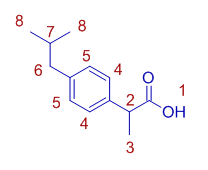I count 7 equivalent absorptions total, but answer says 8. I don't see where this eighth absorption comes from?
Heres how I'm counting starting on right side of molecule:
1 is Carbox acid H
2 is the 1 H just left of the double bonded Oxygen
3 is the 3 H's of the methyl group next to the lone H
4 and 5 are the 2 sets of equivalent H's in the ring structure
6 is is the 2 H's to left of ring
7 is the 2 methlys on the isoproplyl (these are equivalent so same signal)
How do they get 8?



